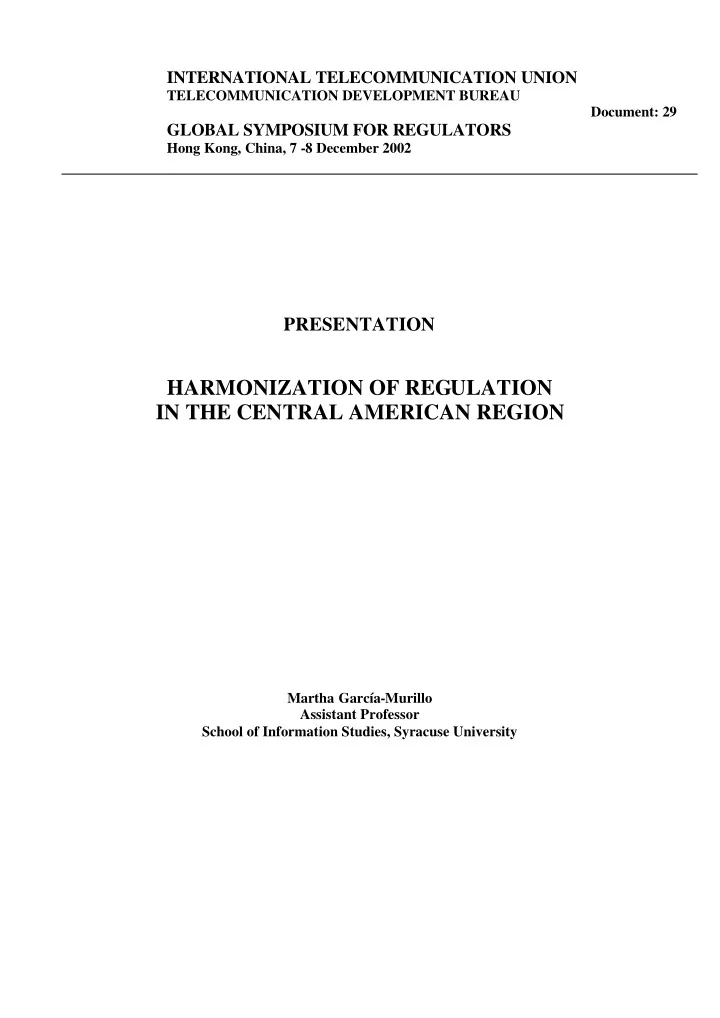

INTERNATIONAL TELECOMMUNICATION UNION TELECOMMUNICATION DEVELOPMENT BUREAU Document: 29 GLOBAL SYMPOSIUM FOR REGULATORS Hong Kong, China, 7 -8 December 2002 PRESENTATION HARMONIZATION OF REGULATION IN THE CENTRAL AMERICAN REGION Martha García-Murillo Assistant Professor School of Information Studies, Syracuse University
International Telecommunication Union Global Symposium for Regulators 7-8 December 2002 Hong Kong Harmonization of Regulation in the Central American Region Martha Garcia-Murillo Sector Reform Unit International Telecommunication Union Outline � The Plan Puebla Panama � Telecommunications in Central America � Analysis of current laws � Recommendations
International Telecommunication Union Reasons for harmonization � Plan Puebla Panama “ To improve the quality of life of the people living in the Central American Region ” � Telecommunications objective “To modernize and extend telecommunications basic and enhanced services to help these communities through the installation of regional fiber or satellite networks” … International Telecommunication Union Central America Overview Country Population Purchasing Power Belice .244 3,250 Costa Rica 4.1 8,500 El Salvador 6.4 4,600 Honduras 6.5 2,600 Guatemala 11.6 3,700 Nicaragua 5.2 2,500 Panamá 2.8 5,900 México 100.3 SSE (27.5) 9,000 (3,207)* * GDP per capita 1998
International Telecommunication Union Poverty and access Country % of Households at or % households with a phone line (1998)* Below Poverty 85 Costa Rica 20 (1997) 28 El Salvador 48 (1997) 21 Guatemala 63 (1989) 22 Honduras 74 (1997) 48 México 38 (1998) 16 Nicaragua - 59 Panamá 27 (1997) * See paper for a complete explanation of the way this number was calculated Fuente: ITU/SRU con datos de ITU World Telecommunications Indicators Database 2002 y UNDP, Human Development Indicators, 2001 (http://hdr.undp.org/reports/global/2001/en/pdf/back.pdf) International Telecommunication Union Telecommunications demand Country Waiting list (2001) Time waiting (2000) Belice 1'608 7.2 meses Costa Rica 19'632 6 meses El Salvador 38'247 NA Guatemala NA NA Honduras* 169'673 7.8 años México NA 45 días Nicaragua* 108'370 9 años Panamá NA NA
International Telecommunication Union Teledensity 40 Líneas por 100 habitantes 36 35 34 31 30 26 22 25 22 20 15 15 16 12 15 9 7 10 6 6 5 8 4 3 3 2 5 1 1 1 3 0 e a o a a c l c c a s a m r i i o l i m a x u e R r e g a d B u e M a n a a d a v t n r t a a P l s a u o c o S G H i C N l E 1980 2001 2001 - fijas y móviles International Telecommunication Union Operators M EXICO Guatemala – (America Movil) TELGUA (P) Honduras – HONDUTEL (S) El Salvador – France Telecom Nicaragua – Telia CTE (P) N ENITEL (P) Panama - CABLE & WIRELESS (P) Costa Rica – ICE (S) Panama Canal Panama Golfo de Panama C O LO M BIA
International Telecommunication Union Reasons for harmonization � Enlargement of the market � Promoting competition � Lowering prices � Improving quality � Elimination of “ forum shopping ” � Support to other PPP projects International Telecommunication Union Classification of services Costa Rica Not specified Honduras Transport services Concession Final services Concession Value added services Registration Radio comms. & broadcasting services Permit Private services Permit Services that require spectrum allocation License Panam á Category A Concession Category B Concession
International Telecommunication Union Interconnection Specifications in the law SV GT HN NI All operators are obliged to allow X X X interconnection in all technically feasible points The interconnection negotiations to X X X X determine the technical and economic conditions will take place between operators When the negotiations among operators X X X* X fail the regulator will intervene to settle the (40) (90) disputes Incumbent operators are obliged to allow X X for interconnection on a non discriminatory basis International Telecommunication Union Rights of way Specifications in the law CR SV GT HN NI PA Telecommunication operators X X X X X have the rights of way The operators will take measures X X that limit harm to property Operators are obliged to comply X with municipal and urban rules The rights of way are free X Operators will need to pay for X their rights of way
International Telecommunication Union Infractions C GT P Infractions SV HN NI R * A N S VS Fail to pay license fees VS C Deny access to essential facilities, VS VS VS change or deny data necessary for billing purposes Disconnect another ’ s operators VS S network without a cause Interfere or damage deliberately N VS VS VS telecommunications network, C systems or services Use of the radio spectrum without a S VS VS license or in a way different from the VS one authorized Create interference for technical M S S reasons International Telecommunication Union Sanctions Type of CR SV GT HN NI PA violation 45,714- 6,029- 694- Very serious 57,143 30,144 1,389 + 571per day 11,429- 10,001- Serious 2,286 + 0-5,969 347-694 100,000 229 per day 1000- Minor 1,143- % of 10,000 1,1429 billing 1,000- 5 to 10 1,000,00 Without times 0 + classificatio damage 100- n value 10,000 1,840- per day 7,360
International Telecommunication Union Recommendations � Solving problems � Cascading upwards � Finding commonalities Functions � Mechanisms for dispute resolution Competition Sanctions Infractions Interconnection Rights of way Licensing
Recommend
More recommend